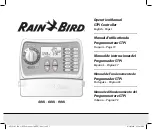
17
F600775R00
Installation
General Manual
Release date: September 2014
4.3
General installation directives
1. Check the contents of the parts kit using the parts list included in the kit.
2. Before start installing the greasing system, check whether the grease point of the
hydraulic hammer is open and furnished with a sufficient amount of grease. If that is
not the case, grease the grease point by hand. This prevents insufficient greasing of the
grease point during the period following the first greasing cycles of the greasing system.
WARNING
No grease must be allowed to come between the bit and the actuator
in the hammer case. Therefore press the bit completely up against the
hammer before lubricating the hydraulic hammer. To do this, place the
hydraulic hammer with the bit on the ground so that the excavator and
the hammer case are resting on the bit.
3. Prevent any contamination of the system during installation. Use clean tools and clean
the locations on the machine where the pump unit and other parts are to be installed.
4. During installation of grease hoses and electric wires, ensure that:
• The hoses and wires are not fastened to or near hot parts such as exhaust, turbo or air
conditioning unit.
• The hoses and wires taut and fixed in place with small or large straps or clamps.
• The hoses and wires are not installed alongside moving parts in such a way that they
may become damaged (in time).
• The hoses and wires have a sufficient length, particularly if they are laid to moving
parts. Check this by shifting the moving parts to its extreme positions.
• Ensure that grommets are used wherever there is a chance of a hose or wire being
damaged.
5. Check whether the machine voltage corresponds to the voltage required for the pump
in the kit.
4.4
Mounting the pump unit
1. Determine jointly with the client where the pump unit should be mounted, if this is not
already indicated in machine-specific installation instructions. Make sure that:
• The pump unit is easily accessible for filling its reservoir.
• The grease level in the reservoir is easy to inspect visually.
• The pump unit is protected against possible damage.
2. Investigate whether existing holes of the machine can be used to mount the mounting
plate of the pump unit.
Always follow the directions of the machine manufacturer when you need to drill holes.
Be sure not to damage anything (e.g. lines or wires) that may be present behind the part
in which you drill a hole. After drilling a hole, always remove the chips (with compressed
air).
3. If the mounting plate is to be welded onto the machine, the directions of the machine
manufacturer should be strictly adhered to.
4. Mount the mounting plate with the pump unit onto the machine.
5. Remove the yellow/red transport plugs from the grease outlet and the de-aerating
opening of the pump unit.
6. Fill the reservoir of the pump (if empty) with hammer grease prescribed by the hammer
manufacturer in a NLGI-2 class.
















































